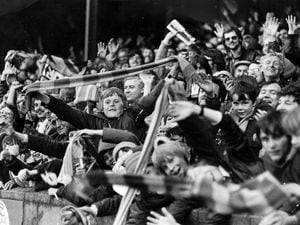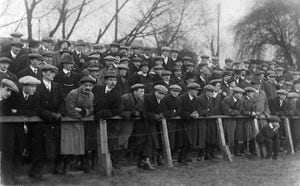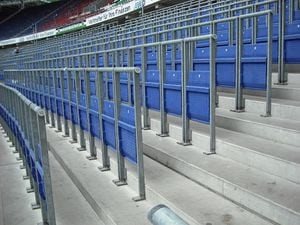Safe standing: Shrewsbury Town set to stand and deliver for fans
Roger Groves recalls watching his beloved Shrewsbury Town clinch promotion to the Second Division on a warm evening in May, 1979.

“We beat Exeter 4-1, and there were 14,000 there that night,” he recalls. “To see the Wakeman and Riverside terraces packed like that was amazing, the atmosphere was incredible.”
It is an experience that will strike a chord with thousands of football fans across the country. Huge crowds would be packed into the tiny terraces, bouncing up and down, and generating an atmosphere that we can only dream of in today’s all-seater stadia.

The Kop, the Holte End, the South Bank at Molineux are rooted in football folklore, places that would make the hairs on the back of the neck stand on end, a throwback to times when the game was less sanitised and commercial. And it is an atmosphere that Mr Davies, and a group of fellow Shrewsbury Town fans are hoping to revive – and that the giants of the Premier League look set to follow.
Shrewsbury Town Supporters Parliament, led by Mr Groves and fellow Shrews fan Mike Davies, have just been given the go-ahead by the Sports Ground Safety Authority to install a “safe-standing” area at the club’s Montgomery Waters Meadow Stadium. Shrewsbury fans have been unable to stand at home games since the club moved from its old Gay Meadow ground 10 years ago but, providing Shropshire Council agrees to change the club's safety certificate, that could change very soon.
Mr Groves says he hopes to install railings, with built-in fold down seats, by next summer at the latest, making Shrewsbury the first club in England to introduce such an area. The plan has received the overwhelming backing of the club’s supporters, with a Shropshire Star poll putting 87 per cent of the club’s fans in favour.
Next week, the group will launch a crowd-funding campaign to raise the £75,000 needed to carry out the adaptations, and it is likely to attract the support of fans across the country who hope what is happening at Shrewsbury will lead to their clubs following suit.

There are still grounds in the lower echelons of the football league which do have standing areas. AFC Wimbledon’s Kingsmeadow stadium, previously the home of non-league Kingstonian, is one, but in the main they are the older grounds which were never upgraded following the Hillsborough disaster. Up until now, no English club has converted an all-seater stadium to include a standing area.
However, the success of safe standing elsewhere, most noticeably at Borussia Dortmund’s Westfalenstadion and Glasgow Celtic’s Parkhead ground, have shown the potential of such schemes, combining the safety and regulation of numbered seating areas, with the energy that standing area’s bring to a game.
“We are trying to recreate that atmosphere of fans on their feet, shouting and singing, trying to suck the ball into the back of the net,” he says.
“At away games too, it makes such a difference when you have got vibrant away supporters behind the goal.”
It will be a local company that will carry out the work too: Atcham-based Ferco Seating, which did the work at Celtic as well as German Bundesliga side Hoffenheim.

Ferco managing director Michael Burnett believes that if Shrewsbury goes ahead with a safe standing area, it will be copied by clubs across England.
“We see it as a great sort of shop window for this product and for the whole idea of safe standing, not necessarily our product,” he says.
“Shrewsbury is a great place, quite close to the geographic centre of England so lots of people can come and see it. I think a lot of Premier League clubs are interested.”
There are three main designs of safe-standing equipment. The more common system, like the one at Celtic, involves barriers with drop down seats, which can be unlocked by ground staff for matches when seating is required, such as European games. Many German clubs employ a system where seats can be clipped into place when needed, and there is a third design where seats can fold down into the floor.
At the moment, the law requires all Premier League and Championship clubs to have all-seater stadia, although clubs being promoted from League One are given up to three years to comply.
Mr Groves says he has been told that if the trial is successful, the likelihood is that the rules will be changed to allow the clubs in the top two tiers to also introduce such a scheme. Wolverhampton Wanderers, Aston Villa and West Bromwich Albion have all given their backing to campaigns to introduce safe standing.
Albion’s director of operations Mark Miles visited Celtic last season, and said in an interview that he had been very impressed by the scheme, which had created a “unique atmosphere.”
However, modern safety requirements mean that the days of packing 30,000 fans into the Holte or the South Bank are unlikely to return.
Mr Groves says the plan at Shrewsbury is to add 500 standing places to the Meadow, replacing the same number of seats.
“We have gone for a like-for-like replacement, like has been tried at Celtic,” he says.
“You can increase the number of spaces, but we felt it was better to follow the tried-and-trusted model for a safety aspect.”
It is also unlikely to make football any more affordable to the fans. Ticket prices for the standing area at Shrewsbury will be the same as the seats they replace. The days of paying two bob for a ticket – or even the £5 it might have cost in the late 1980s – are well and truly over.
Not everybody is in favour of a return to standing at football matches, mind. New legislation which outlawed standing at top-level football grounds was introduced in the wake of the Hillsborough disaster, which saw 96 Liverpool supporters killed in a crush at an FA Cup semi final in 1989. It was reported that then prime minister Margaret Thatcher was horrified by the poor safety and conditions at many football grounds, and it is still a sensitive issue in many quarters.
Mayor of Liverpool and vocal Hillsborough campaigner Steve Rotheram is one of the most outspoken critics in the past, although his stance has now softened.
The former Labour MP previously said “safe-standing is an oxymoron”, and suggested those 96 lives would not have been lost if there were seats in the Leppings Lane Stand where the crush takes place. The issue is particularly raw for Mr Rotheram, who only avoided being in the crush because he had swapped his Leppings Lane ticket for a seat before kick-off.
However, he has recently said that safe standing is something that "should be looked at".
On the other hand, supporters of safe standing point out it is a near-impossible task forcing supporters to remain seated at football games.
“It is far safer standing behind a barrier than standing up in front of a seat,” says Mr Groves.
It is clearly an emotive issue in some quarters, and particularly on Merseyside where opinion is divided between those fiercely opposed because of their memories of Hillsborough, and those who long for the romance of the old Kop.
It does seem, though, that the momentum is with those who want to see a return to standing at matches. And it looks like Shrewsbury will be blazing a trail that the big boys will follow.





